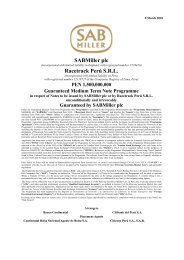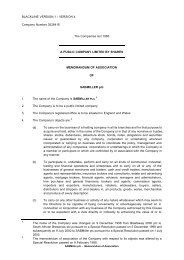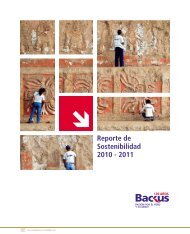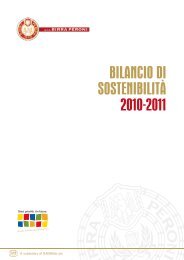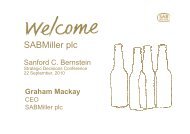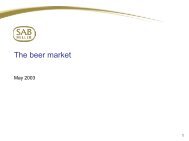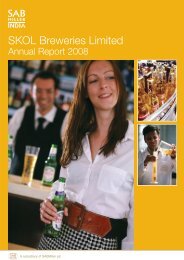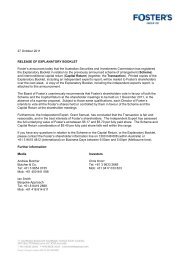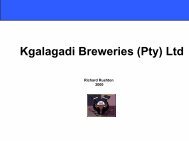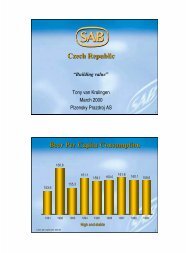Download the National Breweries Zambia 2009 Annual ... - SABMiller
Download the National Breweries Zambia 2009 Annual ... - SABMiller
Download the National Breweries Zambia 2009 Annual ... - SABMiller
Create successful ePaper yourself
Turn your PDF publications into a flip-book with our unique Google optimized e-Paper software.
Financial Statements<br />
for <strong>the</strong> year ended 31st March <strong>2009</strong> (cont.)<br />
The assets’ residual values and useful lives are reviewed, and adjusted if appropriate, at each balance sheet date.<br />
Property, plant and equipment are reviewed for impairment whenever events or changes in circumstances indicate<br />
that <strong>the</strong> carrying amount may not be recoverable. An impairment loss is recognised for <strong>the</strong> amount by which <strong>the</strong><br />
asset’s carrying amount exceeds its recoverable amount. The recoverable amount is <strong>the</strong> higher of an asset’s fair<br />
value less costs to sell and value in use. For <strong>the</strong> purposes of assessing impairment, assets are grouped at <strong>the</strong><br />
lowest levels for which <strong>the</strong>re are separately identifiable cash flows (cash-generating units).<br />
Gains and losses on disposal of property, plant and equipment are determined by reference to <strong>the</strong>ir carrying<br />
amounts and are taken into account in determining profit.<br />
(e) Accounting for leases<br />
Leases in which a significant portion of <strong>the</strong> risks and rewards of ownership are retained by <strong>the</strong> lessor are classified<br />
as operating leases. Payments made under operating leases are charged to <strong>the</strong> profit and loss account on a<br />
straight-line basis over <strong>the</strong> period of <strong>the</strong> lease.<br />
(f) Inventories<br />
Inventories are stated at <strong>the</strong> lower of cost and net realisable value. Cost is determined by <strong>the</strong> Weighted Average<br />
Cost method. The cost of finished goods and work in progress comprises raw materials, direct labour, o<strong>the</strong>r direct<br />
costs and related production overheads (based on normal operating capacity), but excludes borrowing costs. Net<br />
realisable value is <strong>the</strong> estimated selling price in <strong>the</strong> ordinary course of business, less <strong>the</strong> costs of completion and<br />
applicable variable selling expenses.<br />
(g) Receivables<br />
Receivables are recognised initially at fair value and subsequently measured at amortised cost using <strong>the</strong> effective<br />
interest method. A provision for impairment of receivables is established when <strong>the</strong>re is objective evidence that <strong>the</strong><br />
company will not be able to collect all <strong>the</strong> amounts due according to <strong>the</strong> original terms of receivables. The amount<br />
of <strong>the</strong> provision is <strong>the</strong> difference between <strong>the</strong> carrying amount and <strong>the</strong> present value of expected cash flows,<br />
discounted at <strong>the</strong> effective interest rate. The amount of <strong>the</strong> provision is recognised in <strong>the</strong> profit and loss account.<br />
(h) Payables<br />
Payables are recognised initially at fair value and subsequently measured at amortised cost using <strong>the</strong> effective<br />
interest method.<br />
(i) Borrowings<br />
Borrowings are recognised initially at fair value, net of transaction costs incurred. Borrowings are subsequently<br />
stated at amortised cost using <strong>the</strong> effective interest method; any differences between proceeds (net of transaction<br />
costs) and <strong>the</strong> redemption value is recognised in <strong>the</strong> profit and loss account over <strong>the</strong> period of <strong>the</strong> borrowings.<br />
Borrowings are classified as current liabilities unless <strong>the</strong> company has an unconditional right to defer settlement of<br />
<strong>the</strong> liability for at least 12 months after <strong>the</strong> balance sheet date.<br />
(j) Share capital<br />
Ordinary shares are classified as ‘share capital’ in equity.<br />
p24



